Ninja Van's Business Strategies and Operations
VerifiedAdded on 2021/04/24
|11
|2011
|180
AI Summary
This assignment provides an in-depth analysis of Ninja Van's business strategies and operations. The report highlights the company's use of algorithms to resolve delivery issues, its Cash On Delivery facilities, and its return order strategy. Additionally, it discusses Ninja Van's product offerings, including fashion brands and e-commerce sites. The document also examines the competitive landscape, highlighting the need for diversification and building a strong consumer base to stay ahead in the market.
Contribute Materials
Your contribution can guide someone’s learning journey. Share your
documents today.
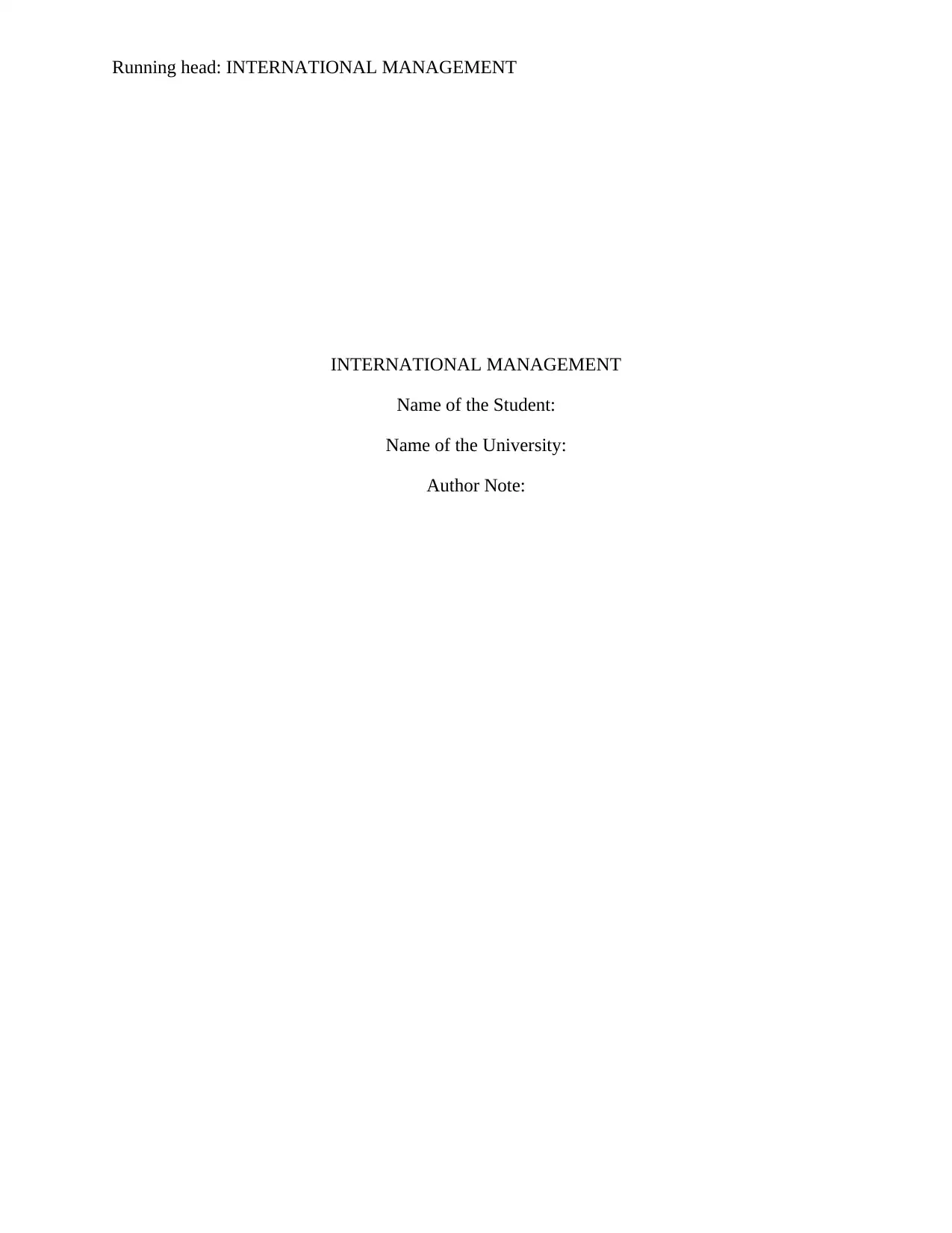
Running head: INTERNATIONAL MANAGEMENT
INTERNATIONAL MANAGEMENT
Name of the Student:
Name of the University:
Author Note:
INTERNATIONAL MANAGEMENT
Name of the Student:
Name of the University:
Author Note:
Secure Best Marks with AI Grader
Need help grading? Try our AI Grader for instant feedback on your assignments.
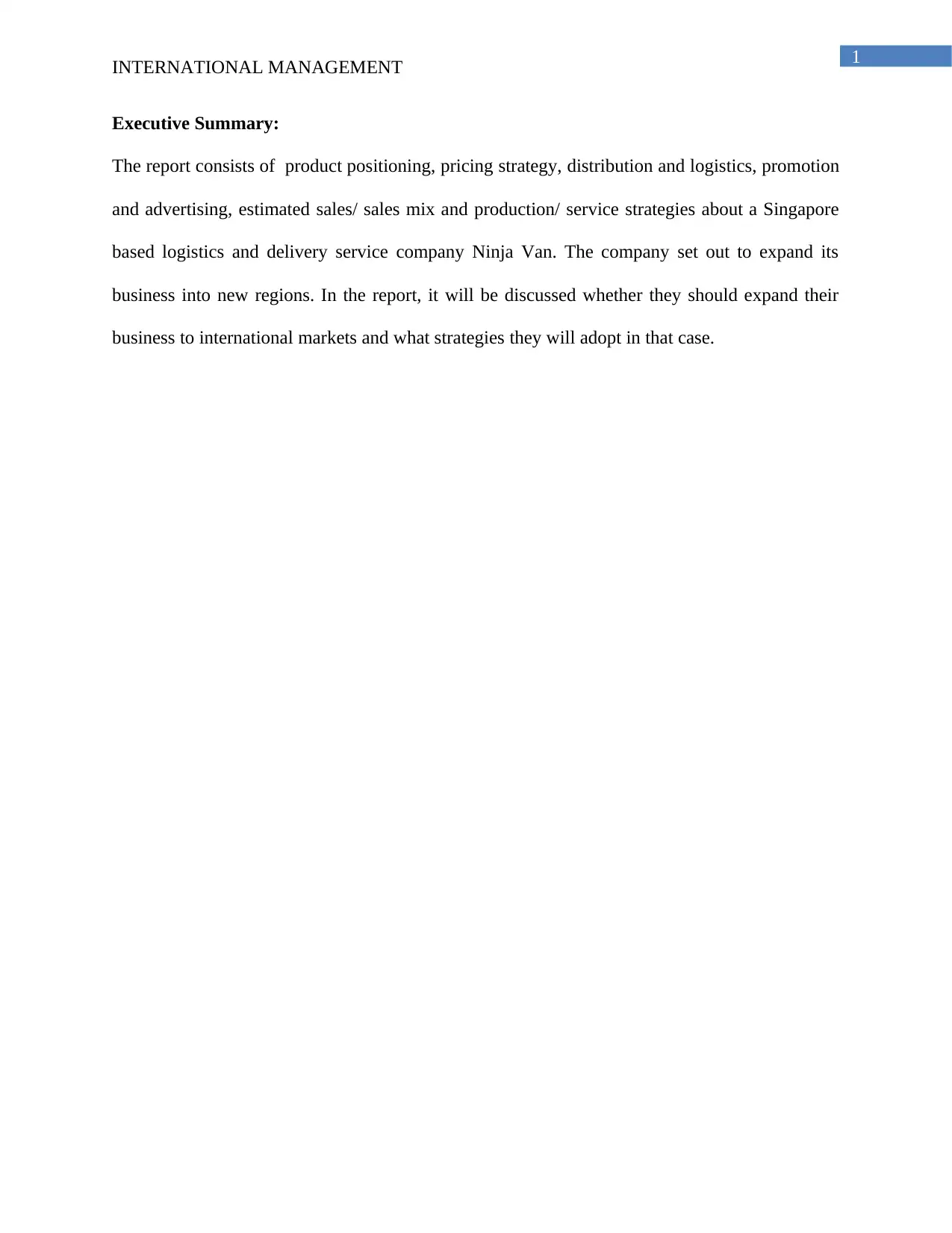
1
INTERNATIONAL MANAGEMENT
Executive Summary:
The report consists of product positioning, pricing strategy, distribution and logistics, promotion
and advertising, estimated sales/ sales mix and production/ service strategies about a Singapore
based logistics and delivery service company Ninja Van. The company set out to expand its
business into new regions. In the report, it will be discussed whether they should expand their
business to international markets and what strategies they will adopt in that case.
INTERNATIONAL MANAGEMENT
Executive Summary:
The report consists of product positioning, pricing strategy, distribution and logistics, promotion
and advertising, estimated sales/ sales mix and production/ service strategies about a Singapore
based logistics and delivery service company Ninja Van. The company set out to expand its
business into new regions. In the report, it will be discussed whether they should expand their
business to international markets and what strategies they will adopt in that case.
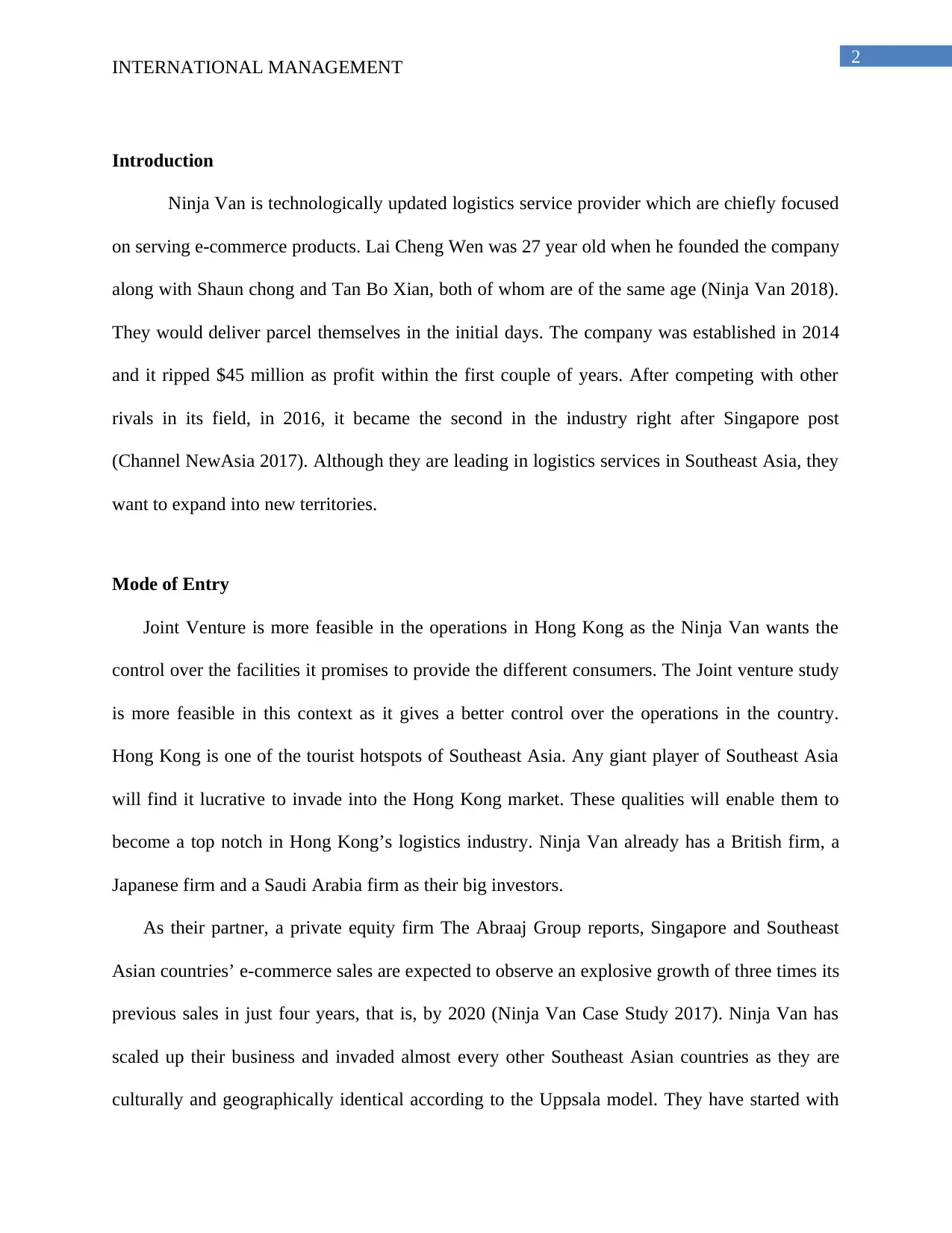
2
INTERNATIONAL MANAGEMENT
Introduction
Ninja Van is technologically updated logistics service provider which are chiefly focused
on serving e-commerce products. Lai Cheng Wen was 27 year old when he founded the company
along with Shaun chong and Tan Bo Xian, both of whom are of the same age (Ninja Van 2018).
They would deliver parcel themselves in the initial days. The company was established in 2014
and it ripped $45 million as profit within the first couple of years. After competing with other
rivals in its field, in 2016, it became the second in the industry right after Singapore post
(Channel NewAsia 2017). Although they are leading in logistics services in Southeast Asia, they
want to expand into new territories.
Mode of Entry
Joint Venture is more feasible in the operations in Hong Kong as the Ninja Van wants the
control over the facilities it promises to provide the different consumers. The Joint venture study
is more feasible in this context as it gives a better control over the operations in the country.
Hong Kong is one of the tourist hotspots of Southeast Asia. Any giant player of Southeast Asia
will find it lucrative to invade into the Hong Kong market. These qualities will enable them to
become a top notch in Hong Kong’s logistics industry. Ninja Van already has a British firm, a
Japanese firm and a Saudi Arabia firm as their big investors.
As their partner, a private equity firm The Abraaj Group reports, Singapore and Southeast
Asian countries’ e-commerce sales are expected to observe an explosive growth of three times its
previous sales in just four years, that is, by 2020 (Ninja Van Case Study 2017). Ninja Van has
scaled up their business and invaded almost every other Southeast Asian countries as they are
culturally and geographically identical according to the Uppsala model. They have started with
INTERNATIONAL MANAGEMENT
Introduction
Ninja Van is technologically updated logistics service provider which are chiefly focused
on serving e-commerce products. Lai Cheng Wen was 27 year old when he founded the company
along with Shaun chong and Tan Bo Xian, both of whom are of the same age (Ninja Van 2018).
They would deliver parcel themselves in the initial days. The company was established in 2014
and it ripped $45 million as profit within the first couple of years. After competing with other
rivals in its field, in 2016, it became the second in the industry right after Singapore post
(Channel NewAsia 2017). Although they are leading in logistics services in Southeast Asia, they
want to expand into new territories.
Mode of Entry
Joint Venture is more feasible in the operations in Hong Kong as the Ninja Van wants the
control over the facilities it promises to provide the different consumers. The Joint venture study
is more feasible in this context as it gives a better control over the operations in the country.
Hong Kong is one of the tourist hotspots of Southeast Asia. Any giant player of Southeast Asia
will find it lucrative to invade into the Hong Kong market. These qualities will enable them to
become a top notch in Hong Kong’s logistics industry. Ninja Van already has a British firm, a
Japanese firm and a Saudi Arabia firm as their big investors.
As their partner, a private equity firm The Abraaj Group reports, Singapore and Southeast
Asian countries’ e-commerce sales are expected to observe an explosive growth of three times its
previous sales in just four years, that is, by 2020 (Ninja Van Case Study 2017). Ninja Van has
scaled up their business and invaded almost every other Southeast Asian countries as they are
culturally and geographically identical according to the Uppsala model. They have started with
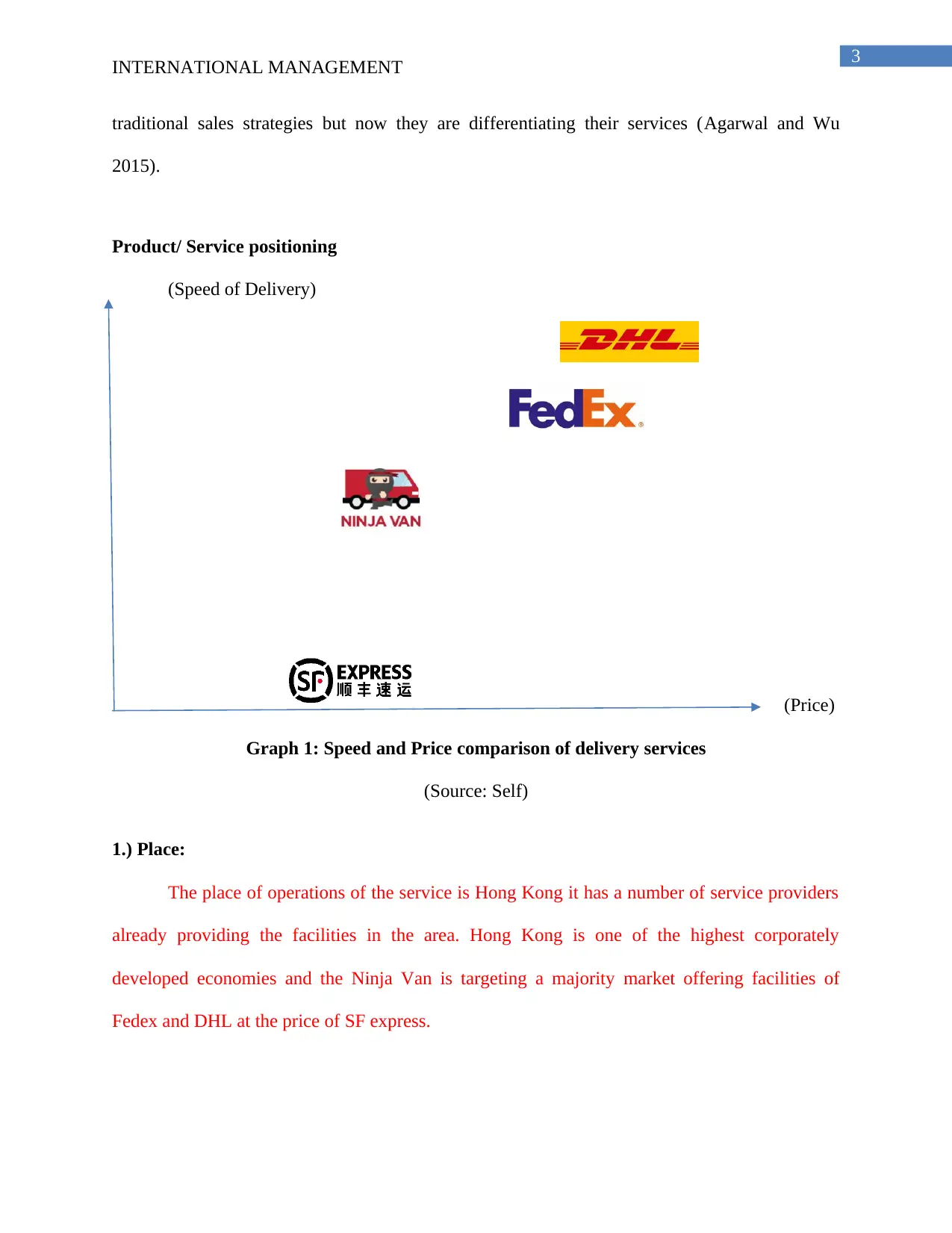
3
INTERNATIONAL MANAGEMENT
traditional sales strategies but now they are differentiating their services (Agarwal and Wu
2015).
Product/ Service positioning
(Speed of Delivery)
(Price)
Graph 1: Speed and Price comparison of delivery services
(Source: Self)
1.) Place:
The place of operations of the service is Hong Kong it has a number of service providers
already providing the facilities in the area. Hong Kong is one of the highest corporately
developed economies and the Ninja Van is targeting a majority market offering facilities of
Fedex and DHL at the price of SF express.
INTERNATIONAL MANAGEMENT
traditional sales strategies but now they are differentiating their services (Agarwal and Wu
2015).
Product/ Service positioning
(Speed of Delivery)
(Price)
Graph 1: Speed and Price comparison of delivery services
(Source: Self)
1.) Place:
The place of operations of the service is Hong Kong it has a number of service providers
already providing the facilities in the area. Hong Kong is one of the highest corporately
developed economies and the Ninja Van is targeting a majority market offering facilities of
Fedex and DHL at the price of SF express.
Secure Best Marks with AI Grader
Need help grading? Try our AI Grader for instant feedback on your assignments.
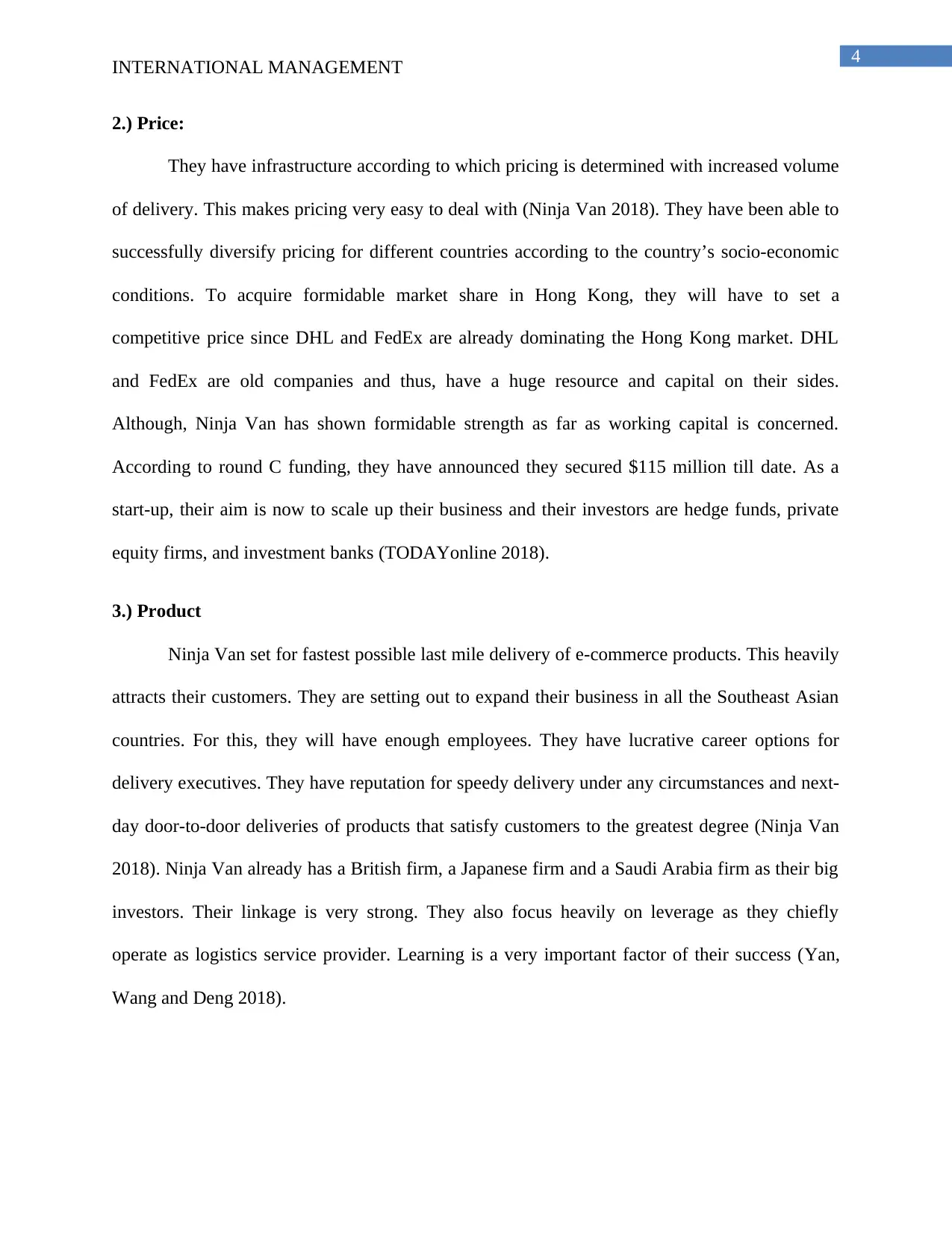
4
INTERNATIONAL MANAGEMENT
2.) Price:
They have infrastructure according to which pricing is determined with increased volume
of delivery. This makes pricing very easy to deal with (Ninja Van 2018). They have been able to
successfully diversify pricing for different countries according to the country’s socio-economic
conditions. To acquire formidable market share in Hong Kong, they will have to set a
competitive price since DHL and FedEx are already dominating the Hong Kong market. DHL
and FedEx are old companies and thus, have a huge resource and capital on their sides.
Although, Ninja Van has shown formidable strength as far as working capital is concerned.
According to round C funding, they have announced they secured $115 million till date. As a
start-up, their aim is now to scale up their business and their investors are hedge funds, private
equity firms, and investment banks (TODAYonline 2018).
3.) Product
Ninja Van set for fastest possible last mile delivery of e-commerce products. This heavily
attracts their customers. They are setting out to expand their business in all the Southeast Asian
countries. For this, they will have enough employees. They have lucrative career options for
delivery executives. They have reputation for speedy delivery under any circumstances and next-
day door-to-door deliveries of products that satisfy customers to the greatest degree (Ninja Van
2018). Ninja Van already has a British firm, a Japanese firm and a Saudi Arabia firm as their big
investors. Their linkage is very strong. They also focus heavily on leverage as they chiefly
operate as logistics service provider. Learning is a very important factor of their success (Yan,
Wang and Deng 2018).
INTERNATIONAL MANAGEMENT
2.) Price:
They have infrastructure according to which pricing is determined with increased volume
of delivery. This makes pricing very easy to deal with (Ninja Van 2018). They have been able to
successfully diversify pricing for different countries according to the country’s socio-economic
conditions. To acquire formidable market share in Hong Kong, they will have to set a
competitive price since DHL and FedEx are already dominating the Hong Kong market. DHL
and FedEx are old companies and thus, have a huge resource and capital on their sides.
Although, Ninja Van has shown formidable strength as far as working capital is concerned.
According to round C funding, they have announced they secured $115 million till date. As a
start-up, their aim is now to scale up their business and their investors are hedge funds, private
equity firms, and investment banks (TODAYonline 2018).
3.) Product
Ninja Van set for fastest possible last mile delivery of e-commerce products. This heavily
attracts their customers. They are setting out to expand their business in all the Southeast Asian
countries. For this, they will have enough employees. They have lucrative career options for
delivery executives. They have reputation for speedy delivery under any circumstances and next-
day door-to-door deliveries of products that satisfy customers to the greatest degree (Ninja Van
2018). Ninja Van already has a British firm, a Japanese firm and a Saudi Arabia firm as their big
investors. Their linkage is very strong. They also focus heavily on leverage as they chiefly
operate as logistics service provider. Learning is a very important factor of their success (Yan,
Wang and Deng 2018).
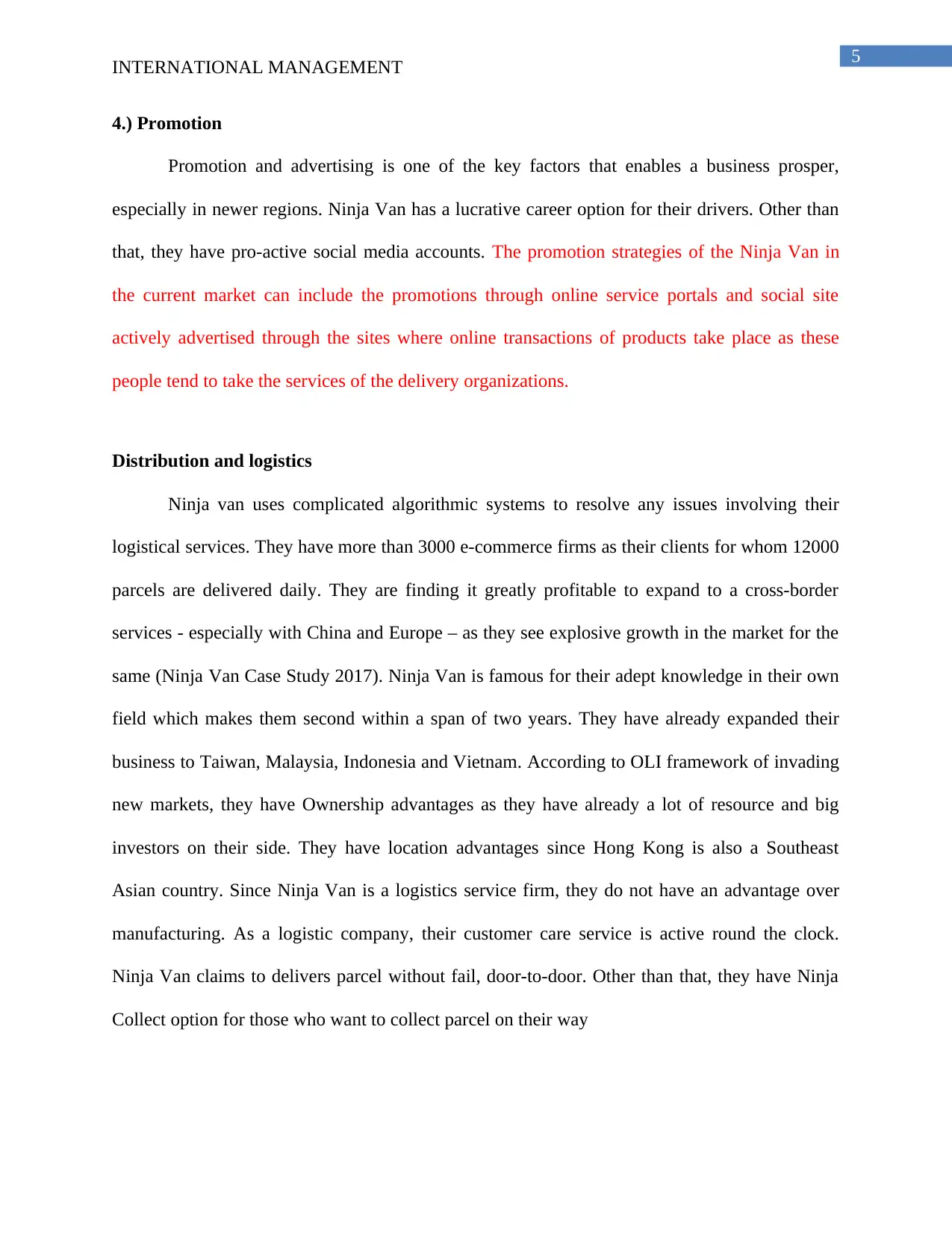
5
INTERNATIONAL MANAGEMENT
4.) Promotion
Promotion and advertising is one of the key factors that enables a business prosper,
especially in newer regions. Ninja Van has a lucrative career option for their drivers. Other than
that, they have pro-active social media accounts. The promotion strategies of the Ninja Van in
the current market can include the promotions through online service portals and social site
actively advertised through the sites where online transactions of products take place as these
people tend to take the services of the delivery organizations.
Distribution and logistics
Ninja van uses complicated algorithmic systems to resolve any issues involving their
logistical services. They have more than 3000 e-commerce firms as their clients for whom 12000
parcels are delivered daily. They are finding it greatly profitable to expand to a cross-border
services - especially with China and Europe – as they see explosive growth in the market for the
same (Ninja Van Case Study 2017). Ninja Van is famous for their adept knowledge in their own
field which makes them second within a span of two years. They have already expanded their
business to Taiwan, Malaysia, Indonesia and Vietnam. According to OLI framework of invading
new markets, they have Ownership advantages as they have already a lot of resource and big
investors on their side. They have location advantages since Hong Kong is also a Southeast
Asian country. Since Ninja Van is a logistics service firm, they do not have an advantage over
manufacturing. As a logistic company, their customer care service is active round the clock.
Ninja Van claims to delivers parcel without fail, door-to-door. Other than that, they have Ninja
Collect option for those who want to collect parcel on their way
INTERNATIONAL MANAGEMENT
4.) Promotion
Promotion and advertising is one of the key factors that enables a business prosper,
especially in newer regions. Ninja Van has a lucrative career option for their drivers. Other than
that, they have pro-active social media accounts. The promotion strategies of the Ninja Van in
the current market can include the promotions through online service portals and social site
actively advertised through the sites where online transactions of products take place as these
people tend to take the services of the delivery organizations.
Distribution and logistics
Ninja van uses complicated algorithmic systems to resolve any issues involving their
logistical services. They have more than 3000 e-commerce firms as their clients for whom 12000
parcels are delivered daily. They are finding it greatly profitable to expand to a cross-border
services - especially with China and Europe – as they see explosive growth in the market for the
same (Ninja Van Case Study 2017). Ninja Van is famous for their adept knowledge in their own
field which makes them second within a span of two years. They have already expanded their
business to Taiwan, Malaysia, Indonesia and Vietnam. According to OLI framework of invading
new markets, they have Ownership advantages as they have already a lot of resource and big
investors on their side. They have location advantages since Hong Kong is also a Southeast
Asian country. Since Ninja Van is a logistics service firm, they do not have an advantage over
manufacturing. As a logistic company, their customer care service is active round the clock.
Ninja Van claims to delivers parcel without fail, door-to-door. Other than that, they have Ninja
Collect option for those who want to collect parcel on their way
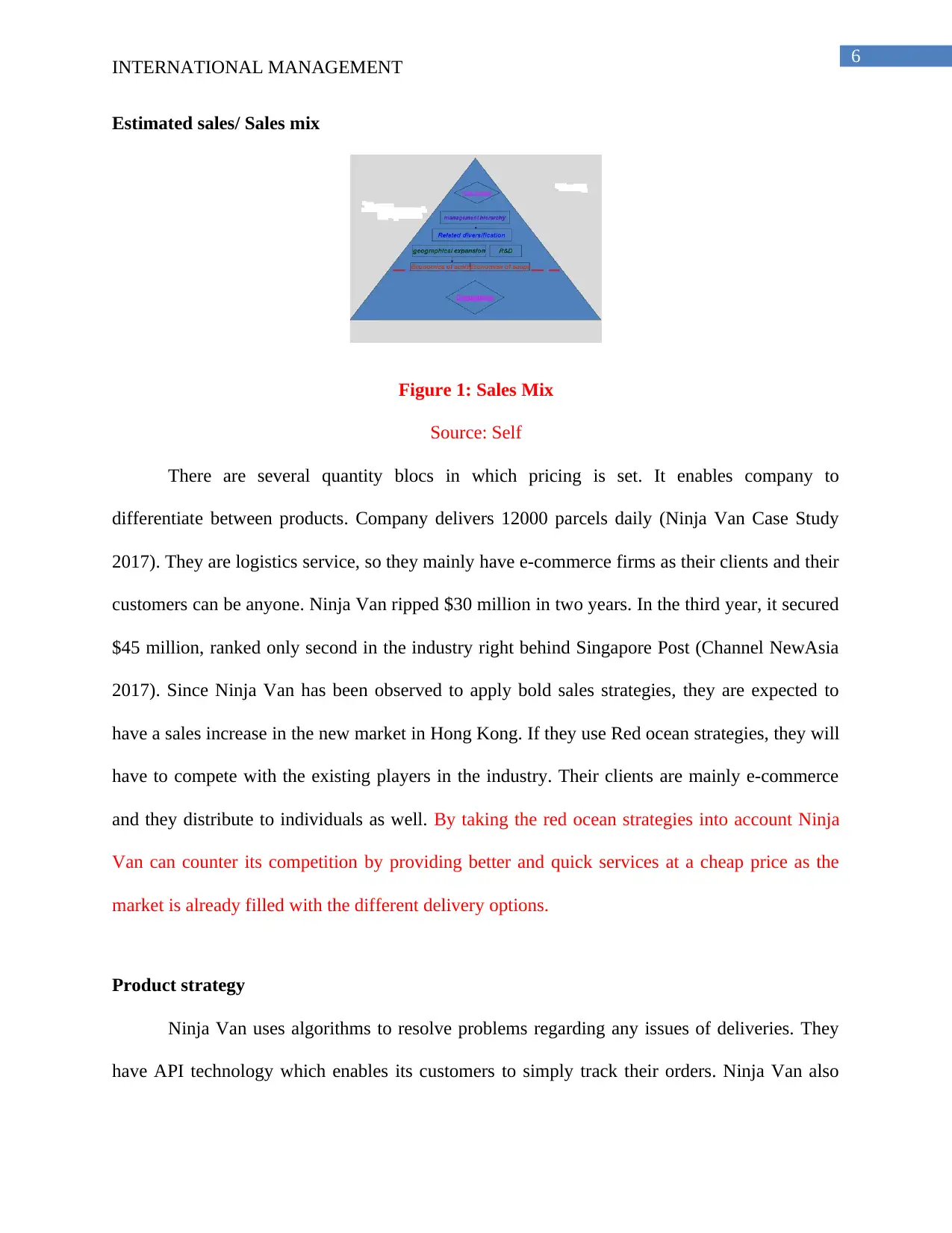
6
INTERNATIONAL MANAGEMENT
Estimated sales/ Sales mix
Figure 1: Sales Mix
Source: Self
There are several quantity blocs in which pricing is set. It enables company to
differentiate between products. Company delivers 12000 parcels daily (Ninja Van Case Study
2017). They are logistics service, so they mainly have e-commerce firms as their clients and their
customers can be anyone. Ninja Van ripped $30 million in two years. In the third year, it secured
$45 million, ranked only second in the industry right behind Singapore Post (Channel NewAsia
2017). Since Ninja Van has been observed to apply bold sales strategies, they are expected to
have a sales increase in the new market in Hong Kong. If they use Red ocean strategies, they will
have to compete with the existing players in the industry. Their clients are mainly e-commerce
and they distribute to individuals as well. By taking the red ocean strategies into account Ninja
Van can counter its competition by providing better and quick services at a cheap price as the
market is already filled with the different delivery options.
Product strategy
Ninja Van uses algorithms to resolve problems regarding any issues of deliveries. They
have API technology which enables its customers to simply track their orders. Ninja Van also
INTERNATIONAL MANAGEMENT
Estimated sales/ Sales mix
Figure 1: Sales Mix
Source: Self
There are several quantity blocs in which pricing is set. It enables company to
differentiate between products. Company delivers 12000 parcels daily (Ninja Van Case Study
2017). They are logistics service, so they mainly have e-commerce firms as their clients and their
customers can be anyone. Ninja Van ripped $30 million in two years. In the third year, it secured
$45 million, ranked only second in the industry right behind Singapore Post (Channel NewAsia
2017). Since Ninja Van has been observed to apply bold sales strategies, they are expected to
have a sales increase in the new market in Hong Kong. If they use Red ocean strategies, they will
have to compete with the existing players in the industry. Their clients are mainly e-commerce
and they distribute to individuals as well. By taking the red ocean strategies into account Ninja
Van can counter its competition by providing better and quick services at a cheap price as the
market is already filled with the different delivery options.
Product strategy
Ninja Van uses algorithms to resolve problems regarding any issues of deliveries. They
have API technology which enables its customers to simply track their orders. Ninja Van also
Paraphrase This Document
Need a fresh take? Get an instant paraphrase of this document with our AI Paraphraser
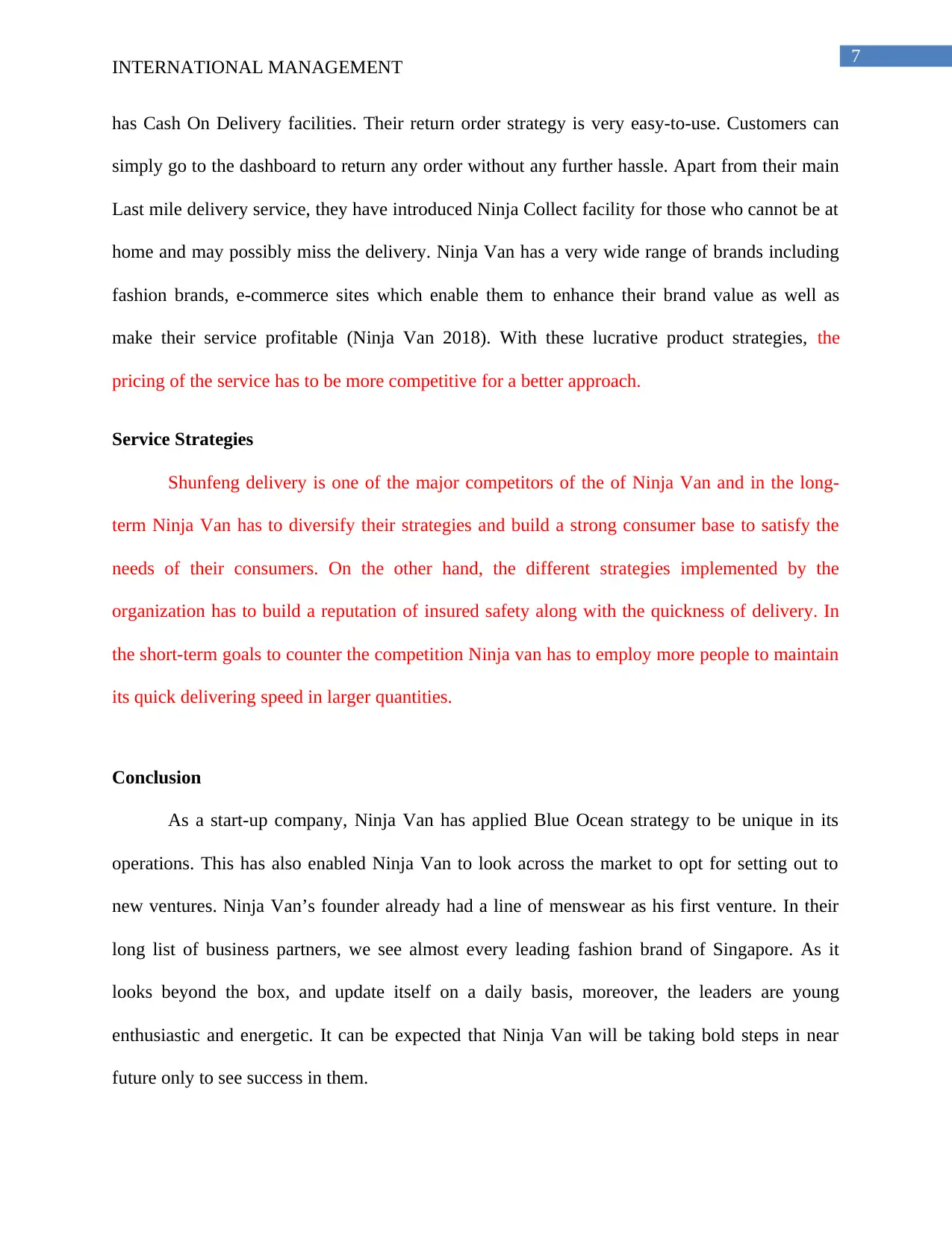
7
INTERNATIONAL MANAGEMENT
has Cash On Delivery facilities. Their return order strategy is very easy-to-use. Customers can
simply go to the dashboard to return any order without any further hassle. Apart from their main
Last mile delivery service, they have introduced Ninja Collect facility for those who cannot be at
home and may possibly miss the delivery. Ninja Van has a very wide range of brands including
fashion brands, e-commerce sites which enable them to enhance their brand value as well as
make their service profitable (Ninja Van 2018). With these lucrative product strategies, the
pricing of the service has to be more competitive for a better approach.
Service Strategies
Shunfeng delivery is one of the major competitors of the of Ninja Van and in the long-
term Ninja Van has to diversify their strategies and build a strong consumer base to satisfy the
needs of their consumers. On the other hand, the different strategies implemented by the
organization has to build a reputation of insured safety along with the quickness of delivery. In
the short-term goals to counter the competition Ninja van has to employ more people to maintain
its quick delivering speed in larger quantities.
Conclusion
As a start-up company, Ninja Van has applied Blue Ocean strategy to be unique in its
operations. This has also enabled Ninja Van to look across the market to opt for setting out to
new ventures. Ninja Van’s founder already had a line of menswear as his first venture. In their
long list of business partners, we see almost every leading fashion brand of Singapore. As it
looks beyond the box, and update itself on a daily basis, moreover, the leaders are young
enthusiastic and energetic. It can be expected that Ninja Van will be taking bold steps in near
future only to see success in them.
INTERNATIONAL MANAGEMENT
has Cash On Delivery facilities. Their return order strategy is very easy-to-use. Customers can
simply go to the dashboard to return any order without any further hassle. Apart from their main
Last mile delivery service, they have introduced Ninja Collect facility for those who cannot be at
home and may possibly miss the delivery. Ninja Van has a very wide range of brands including
fashion brands, e-commerce sites which enable them to enhance their brand value as well as
make their service profitable (Ninja Van 2018). With these lucrative product strategies, the
pricing of the service has to be more competitive for a better approach.
Service Strategies
Shunfeng delivery is one of the major competitors of the of Ninja Van and in the long-
term Ninja Van has to diversify their strategies and build a strong consumer base to satisfy the
needs of their consumers. On the other hand, the different strategies implemented by the
organization has to build a reputation of insured safety along with the quickness of delivery. In
the short-term goals to counter the competition Ninja van has to employ more people to maintain
its quick delivering speed in larger quantities.
Conclusion
As a start-up company, Ninja Van has applied Blue Ocean strategy to be unique in its
operations. This has also enabled Ninja Van to look across the market to opt for setting out to
new ventures. Ninja Van’s founder already had a line of menswear as his first venture. In their
long list of business partners, we see almost every leading fashion brand of Singapore. As it
looks beyond the box, and update itself on a daily basis, moreover, the leaders are young
enthusiastic and energetic. It can be expected that Ninja Van will be taking bold steps in near
future only to see success in them.

8
INTERNATIONAL MANAGEMENT
INTERNATIONAL MANAGEMENT
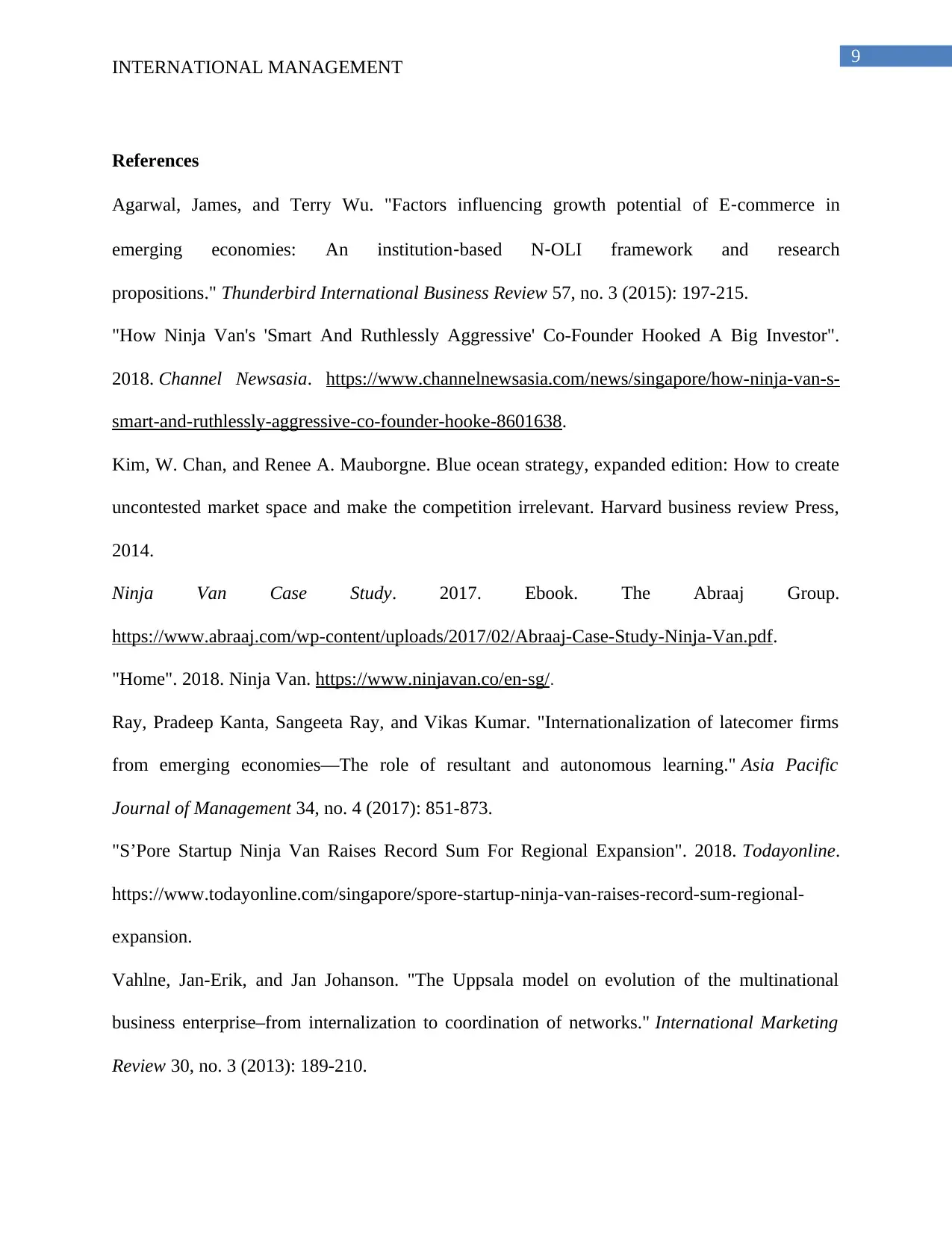
9
INTERNATIONAL MANAGEMENT
References
Agarwal, James, and Terry Wu. "Factors influencing growth potential of E‐commerce in
emerging economies: An institution‐based N‐OLI framework and research
propositions." Thunderbird International Business Review 57, no. 3 (2015): 197-215.
"How Ninja Van's 'Smart And Ruthlessly Aggressive' Co-Founder Hooked A Big Investor".
2018. Channel Newsasia. https://www.channelnewsasia.com/news/singapore/how-ninja-van-s-
smart-and-ruthlessly-aggressive-co-founder-hooke-8601638.
Kim, W. Chan, and Renee A. Mauborgne. Blue ocean strategy, expanded edition: How to create
uncontested market space and make the competition irrelevant. Harvard business review Press,
2014.
Ninja Van Case Study. 2017. Ebook. The Abraaj Group.
https://www.abraaj.com/wp-content/uploads/2017/02/Abraaj-Case-Study-Ninja-Van.pdf.
"Home". 2018. Ninja Van. https://www.ninjavan.co/en-sg/.
Ray, Pradeep Kanta, Sangeeta Ray, and Vikas Kumar. "Internationalization of latecomer firms
from emerging economies—The role of resultant and autonomous learning." Asia Pacific
Journal of Management 34, no. 4 (2017): 851-873.
"S’Pore Startup Ninja Van Raises Record Sum For Regional Expansion". 2018. Todayonline.
https://www.todayonline.com/singapore/spore-startup-ninja-van-raises-record-sum-regional-
expansion.
Vahlne, Jan-Erik, and Jan Johanson. "The Uppsala model on evolution of the multinational
business enterprise–from internalization to coordination of networks." International Marketing
Review 30, no. 3 (2013): 189-210.
INTERNATIONAL MANAGEMENT
References
Agarwal, James, and Terry Wu. "Factors influencing growth potential of E‐commerce in
emerging economies: An institution‐based N‐OLI framework and research
propositions." Thunderbird International Business Review 57, no. 3 (2015): 197-215.
"How Ninja Van's 'Smart And Ruthlessly Aggressive' Co-Founder Hooked A Big Investor".
2018. Channel Newsasia. https://www.channelnewsasia.com/news/singapore/how-ninja-van-s-
smart-and-ruthlessly-aggressive-co-founder-hooke-8601638.
Kim, W. Chan, and Renee A. Mauborgne. Blue ocean strategy, expanded edition: How to create
uncontested market space and make the competition irrelevant. Harvard business review Press,
2014.
Ninja Van Case Study. 2017. Ebook. The Abraaj Group.
https://www.abraaj.com/wp-content/uploads/2017/02/Abraaj-Case-Study-Ninja-Van.pdf.
"Home". 2018. Ninja Van. https://www.ninjavan.co/en-sg/.
Ray, Pradeep Kanta, Sangeeta Ray, and Vikas Kumar. "Internationalization of latecomer firms
from emerging economies—The role of resultant and autonomous learning." Asia Pacific
Journal of Management 34, no. 4 (2017): 851-873.
"S’Pore Startup Ninja Van Raises Record Sum For Regional Expansion". 2018. Todayonline.
https://www.todayonline.com/singapore/spore-startup-ninja-van-raises-record-sum-regional-
expansion.
Vahlne, Jan-Erik, and Jan Johanson. "The Uppsala model on evolution of the multinational
business enterprise–from internalization to coordination of networks." International Marketing
Review 30, no. 3 (2013): 189-210.
Secure Best Marks with AI Grader
Need help grading? Try our AI Grader for instant feedback on your assignments.

10
INTERNATIONAL MANAGEMENT
Yan, Haifeng, Juan Wang, and Ping Deng. "Outbound linkage and inbound leverage for
emerging multinationals: A signaling theory perspective." Asia Pacific Journal of
Management(2018): 1-26.
INTERNATIONAL MANAGEMENT
Yan, Haifeng, Juan Wang, and Ping Deng. "Outbound linkage and inbound leverage for
emerging multinationals: A signaling theory perspective." Asia Pacific Journal of
Management(2018): 1-26.
1 out of 11
Your All-in-One AI-Powered Toolkit for Academic Success.
+13062052269
info@desklib.com
Available 24*7 on WhatsApp / Email
![[object Object]](/_next/static/media/star-bottom.7253800d.svg)
Unlock your academic potential
© 2024 | Zucol Services PVT LTD | All rights reserved.